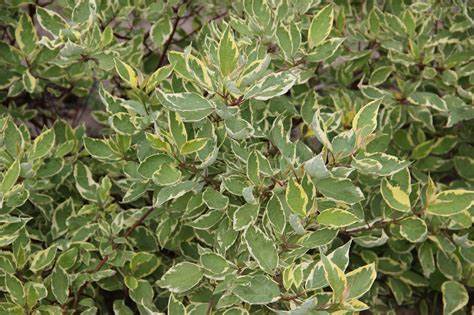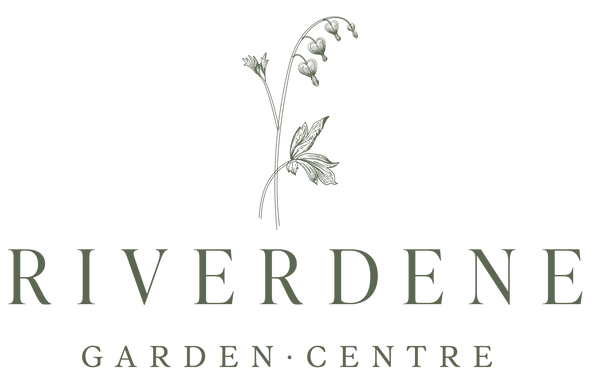Riverdene Garden Center
Ivory Halo Dogwood
Ivory Halo Dogwood
Couldn't load pickup availability
Cornus alba ‘Bailhalo’
The Ivory Halo® Dogwood is a compact, variegated variety of red-twig dogwood, prized for its green-and-white foliage, bright red stems in winter, and small white flowers in spring. It is a low-maintenance, cold-hardy, and drought-tolerant shrub, making it an excellent choice for hedges, foundation plantings, mixed borders, and winter interest landscapes in Southwest Saskatchewan.
Planting & Growing Conditions
- Hardiness Zone: 3-7 (exceptionally winter-hardy, ideal for prairie climates)
- Mature Size: 5-6 feet tall, 5-6 feet wide (more compact than standard red-twig dogwoods)
- Growth Rate: Moderate (6-12 inches per year)
- Sunlight Needs: Full sun to partial shade (best foliage color and red stems in full sun)
-
Soil Requirements:
- Prefers moist, well-drained soil
- Tolerates clay, sandy, and wet soils (ideal for rain gardens or areas with fluctuating moisture)
- Avoid prolonged drought unless well-established
-
Spacing:
- Hedges or screens: 3-5 feet apart
- Individual plantings: 5-6 feet apart
Watering & Maintenance
-
Young Plants (First Year):
- Water deeply 2-3 times per week to establish roots
-
Established Shrubs:
- Prefers consistent moisture, especially in dry summers
- Tolerates periodic drought but thrives with regular watering
-
Mulching:
- Apply a 2-3 inch layer of mulch around the base to retain moisture and regulate soil temperature
Fertilizing
- First Year: No fertilizer needed—focus on root establishment
-
Mature Shrubs:
- Apply a slow-release balanced fertilizer (e.g., 10-10-10) in early spring
- Organic alternative: Compost or well-rotted manure in spring
- Avoid excessive nitrogen, which can reduce winter stem color intensity
Pruning & Maintenance
- Best Time to Prune: Late winter to early spring, before new growth starts
-
How to Prune:
- Remove older stems (over 3 years old) to encourage vibrant new red growth
- Thin out dead or weak branches to maintain shape and air circulation
- Every 2-3 years, cut back one-third of the oldest stems for rejuvenation
- For maximum red stem color, cut the entire shrub down to 6-12 inches every 3-5 years
Flowers, Foliage & Seasonal Interest
- Bloom Time: Late spring to early summer (May-June)
- Flower Color: Small, creamy-white clusters (attracts pollinators)
-
Fruit:
- Small white berries appear in late summer to fall (loved by birds but mildly toxic to humans)
-
Foliage:
- Spring & Summer: Bright green leaves with creamy-white variegation (provides a unique contrast in gardens)
- Fall: Leaves turn pink, burgundy, or reddish-purple before dropping
-
Winter Interest:
- Brilliant red stems stand out in snowy landscapes
Pest & Disease Management
Resistant to: Deer, rabbits, urban pollution, and most pests
Common Pests:
-
Aphids & Scale Insects – Can cause curling leaves
- Solution: Use insecticidal soap or introduce ladybugs
-
Spider Mites – May appear in hot, dry conditions
- Solution: Hose off with water or apply insecticidal soap
Common Diseases:
-
Leaf Spot & Powdery Mildew – Can cause discoloration
- Solution: Improve airflow and avoid overhead watering
-
Canker & Root Rot – Can occur in poorly drained soils
- Solution: Ensure proper drainage and prune out affected branches
Winter Protection
- Highly winter-hardy—no special protection needed in Zone 3+
-
Mulching:
- Apply 2-4 inches of mulch around the base for added root insulation
-
Pruning for color:
- Cut back old stems in late winter to promote fresh, bright red growth
Landscape Uses
Perfect for hedges, foundation plantings, and mixed borders
Compact size makes it great for small gardens
Tolerates wet soils, making it ideal for rain gardens
Attracts birds and pollinators
Bright red stems provide winter interest
Popular Companion Plants:
- Evergreens (Spruce, Juniper, or Cedar) – Provides contrast with winter red stems
- Ornamental Grasses (Karl Foerster, Blue Oat Grass) – Adds texture and movement
- Hostas & Astilbes – Good for shade plantings under taller dogwoods
- Black-Eyed Susan & Coneflowers – Pair well for summer color
Additional Notes:
- Ivory Halo® Dogwood is an improved, compact variety of red-twig dogwood, making it a better fit for smaller landscapes
- Lifespan: 20+ years with proper care
- Works well in formal gardens, cottage-style plantings, and wildlife-friendly landscapes
Photo courtesy of Jeffries Nurseries
Share


